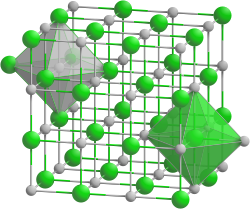 | |
| Names | |
|---|---|
| IUPAC name Phosphanylidyneyttrium | |
| Other names Yttrium phosphide, yttrium(III) phosphide. | |
| Identifiers | |
3D model (JSmol) | |
| ChemSpider | |
| ECHA InfoCard | 100.032.318 |
| EC Number |
|
PubChem CID | |
CompTox Dashboard (EPA) | |
| |
| |
| Properties | |
| PY | |
| Molar mass | 119.879600 |
| Appearance | Colourless solid |
| Density | 4.35 g/cm3 [1] |
| Melting point | 200.78 °C (393.40 °F; 473.93 K) |
| Boiling point | 511.30 °C (952.34 °F; 784.45 K) |
| Structure [2] | |
| Rock salt structure | |
| Fm3m | |
a = 0.5661 nm | |
Formula units (Z) | 4 |
| Octahedral at Y3+, Octahedral at P3- | |
| Related compounds | |
Other anions | Yttrium nitride Yttrium(III) arsenide Yttrium(III) antimonide |
Other cations | Scandium phosphide Lutetium phosphide |
Except where otherwise noted, data are given for materials in their standard state (at 25 °C [77 °F], 100 kPa). | |
Yttrium phosphide is an inorganic compound of yttrium and phosphorus with the chemical formula YP. [3] [4] [5] The compound may be also classified as yttrium(III) phosphide.